Xiamen University
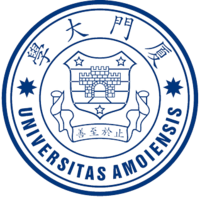 |
|
Latin: Universitas Amoiensis |
Former name |
Amoy University |
|---|
| Motto |
自强不息, 止于至善[1] |
|---|
Motto in English |
Pursue Excellence, Strive for Perfection[1] |
|---|
| Type |
National university |
|---|
| Established |
1921 |
|---|
| President |
Zhu Chongshi |
|---|
Academic staff |
4,600+ |
|---|
| Students |
28,133 |
|---|
| Undergraduates |
17,847 |
|---|
| Postgraduates |
10,286
(PhD 1,501 Master 8,785) |
|---|
| Location |
Xiamen, Fujian, China |
|---|
| Campus |
urban, 524.3 ha |
|---|
| Nickname |
Xia Da |
|---|
| Affiliations |
Global U8 (GU8) |
|---|
| Website |
www.xmu.edu.cn |
|---|
Xiamen University (simplified Chinese: 厦门大学; traditional Chinese: 廈門大學; pinyin: Xiàmén Dàxué; Pe̍h-ōe-jī: Ē-mn̂g Tāi-ha̍k), colloquially known as Xia Da (Chinese: 厦大; pinyin: Xià Dà), located in Xiamen, Fujian province, is the first university in China founded by overseas Chinese. Established by Tan Kah Kee in 1921, the university was originally known as Amoy University. The university is one of many comprehensive universities directly administered by the Chinese Ministry of Education.
According to University Undergraduates Teaching Assessment and Chinese Universities Evaluation Standings, the university is ranked 11th in China and has maintained a top-20 ranking in China, among which 6 subjects reach A++ level, including economics and management, fine art, law, chemistry, journalism, communication and mathematics. In addition, the School of Management is accredited by EQUIS and the Association of MBAs.
History

Panoramic view of the university

Statue of Mr. Tan Kah Kee, in front of his memorial hall located within Xiamen University.
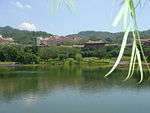
Furong Lake

Jiannan Auditorium
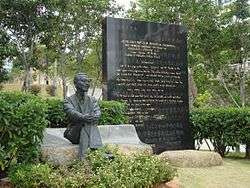
Statue of Tan Kinglun, Xiamen University

The Jiannan Auditorium of Xiamen University

The Baicheng Sportsground of Xiamen University
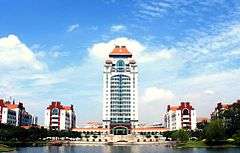
Xiamen University
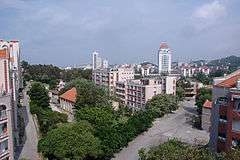
The Xiamen University campus with the "Kah Kee" building complex in the center and student dorms in the foreground
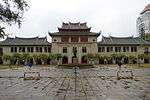
Qunxian Building
In 1919, Tan Kah Kee, a well-known overseas Chinese leader, donated millions of dollars to establish and endow Amoy University in Xiamen (then called Amoy in English), which was officially founded in 1921. Tan handed over Amoy University to the government in 1937 due to lack of funds, and the institution subsequently became a national university. In 1938, at the outbreak of the Second Sino-Japanese War, the university temporarily relocated to Changting in western Fujian.
At the end of World War II in 1946, Amoy University moved back to Xiamen and resumed normal operations. In 1952 it became a comprehensive university embracing both arts and science. In 1963, it was designated as a state key university. Its English name was changed to Xiamen University in the 1970s,[2] to reflect the change of Amoy's English name to Xiamen. In 1995 it was included in the list of the 211 Project for the state key construction; in 2000 it became one of China's higher-level universities designated for the state key construction of the 985 Project.
Xiamen University has long been considered as a "diplomatic cradle" where many children of Chinese and foreign dignitaries go for their tertiary education. Although the actual reason for the high concentration of children of diplomats is unknown, it is rumored that the reason is due to the abundance of foreign national professors as well as its ease of access to southern Asian countries in case of national emergencies. Various wealthy Hong Kong families also seem to like Xiamen University as a reputable place for their children.
Campus
Xiamen University's main campus is located in Siming District in southwestern Xiamen. It is situated at the foothills of mountains, facing the ocean and surrounded by Xiamen's bay. The main campus is picturesque with beautiful scenery and parks and is one of the main tourist attractions in Xiamen, itself a popular tourist destination. The university also has campuses in Xiang'an[3][4] and Zhangzhou.
Xiamen University has a built area of 2.6 million square meters and its libraries hold 3.5 million volumes. The scope and level of its high-speed information network on campus is rated at the top of all universities in China and has become one of the main nodes of CERNET2.
Faculties
At 1 June 2004, Xiamen University had 20 schools containing 43 departments, and many key research institutes.
Famous alumni
See also
References
External links
Coordinates: 24°26′18″N 118°05′35″E / 24.438259°N 118.093153°E / 24.438259; 118.093153
|
|---|
| | | | Districts | |
|---|
| | Education | |
|---|
| Attractions
and tourism | |
|---|
| Culture
and sports | |
|---|
| | Transport | |
|---|
| |
|






